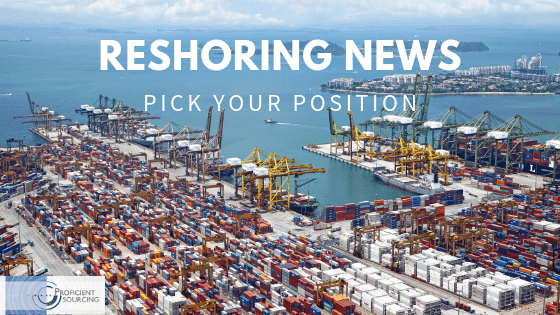
We have been interested in reshoring information for several years, and found 2 newsworthy items recently:
Number 1: “Manufacturing jobs returning to the United States from offshore climbed to 171,000 in 2017 for a staggering 2800-percent increase since 2010, and equaling 90 percent of the 189,000 total manufacturing jobs added in 2017. This brought the number of jobs returned to more than one-half million since 2010. With at least half of these jobs believed to be at various levels of the supply chain, opportunities are great for metalformers.”
On the other hand, here is #2: “Imports of manufactured goods into the United States from the 14 largest low-cost-country trading partners in Asia rose by a staggering $55 billion, or 8 percent – the largest one-year increase since the economic recovery of 2011… Relative growth of imports from the low-cost country trading partners has now outpaced relative growth of US manufacturing gross output in four of the past five years and eight of the past 10 years, showing a clear direction away from significant reshoring. Since 2013, when A.T. Kearney first started studying reshoring as a phenomenon, imports of manufactured goods from the 14 largest low-cost countries have increased by $118 billion, or 19 percent, while US manufacturing gross output has grown by only $81 billion, or 1 percent.”
If you see these two paragraphs as conflicting information, we agree. The first is from the Reshoring Initiative and the 2nd is from the Forbes 7/11/18 article “U.S. Manufacturers Are Not Reshoring”.
So: what is the reshoring situation? We believe as the complexity of the product increases, or as precision increases, there is increasing evidence that reshoring into, or at least near (near shoring), becomes more attractive. The reason is quality. Essentially, if you want superior quality, the US is the place to be.
“Quality is the most frequently cited reason for reshoring manufacturing to the United States. According to the Reshoring Initiative’s 2017 Data Report, quality cost ranked number one as the most frequently mentioned negative factor experienced offshore from 2010 through 2017. Company brand value of having a Made in USA product, a factor directly linked with perceived quality, ranked fourth in the positive domestic factors. Both measures are for reshoring by U.S. headquartered companies and foreign direct investment (FDI) to the U.S. by foreign companies. While quality cost remains one of the most common offshore problems, it is often overlooked in sourcing decisions. Companies too often accept lower product and service quality to save on cost. We will demonstrate that for an increasing percentage of imported products, companies can have domestic quality and availability without impacting profitability.”
The above is from a 3rd article–this one in Quality magazine. The authors of this article are Reshoring Institute people, so be advised of the clear bias in these data. Yet, the Total Cost of Ownership tool that the Reshoring Institute offers is a very good way to evaluate relative costs of manufacturing in competing countries. It would certainly make sense that quality costs might be overlooked, or found difficult to estimate.
We have a great interest in OEM reshoring activities, since we provide candidates for outsourcing manufactured components. In fact, we are interested in OEM sourcing needs generally, and should that be your situation, please give us a call at (513) 489-5252. We are ready whenever you are!

